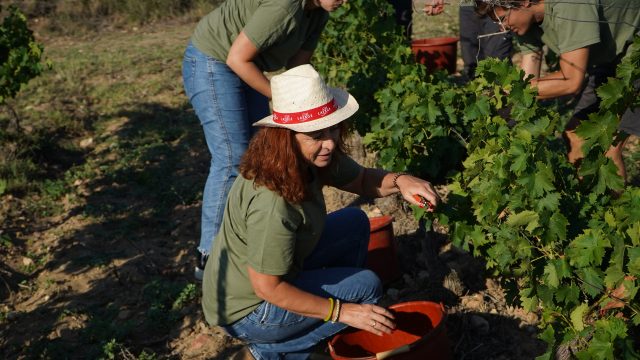This website uses cookies so that we can provide you with the best user experience possible. Cookie information is stored in your browser and performs functions such as recognising you when you return to our website and helping our team to understand which sections of the website you find most interesting and useful.
Roussillon’s Domaine Lafage first to start harvest in France
Jean-Marc Lafage from Roussillon’s Domaine Lafage told db this morning that he is the first producer to start harvesting in France, with picking beginning on 2 August in what has been a drought year in his region.

Harvesting began at Domaine Lafage on Wednesday this week with Muscat à Petits Grains, which is used as part of a lower-alcohol dry white blend called Miraflors along with grapes Macabeo and Colombard.
The wine has an abv around 10.2% and a slight fizz to create a light, refreshing style, he told db.
As for this year’s growing conditions, he said that there had been a drought in Roussillon, with one third the amount of rainfall compared to the average over the last 20 years in the region, with Lafage recording just 200mm in total for 2023.
Despite such extremely low levels of rainfall, which he said were similar to Jordan – “where you find no vines” – he said that his vineyards near the sea, or high in the mountains had fared well.
Those vineyards in areas in-between, where traditionally grapes were grown to make fortified wine, he said “were suffering a lot”, and he expects to lose as much as 60% of the crop.
However, where Domaine Lafage has practised regenerative viticulture, which sees the ground permanently covered due to no tilling of the soil, he said that yields should be higher.
“We are seeing some great results in vineyards in regenerative viticulture and all the places where we are using biochar and cover crops,” he said.
Continuing, he recorded, “In these places, instead of losing 60% of the crop [due to desiccation], we are seeing maybe a 25-30% reduction [in yields], and we see fresh grapes and bigger berries.”
He added, “Where there is a cover crop the berries are nearly twice the size, around 0.8-1 grams per berry, compared to 0.5g elsewhere.”
Explaining the difference he told db that “having the cover crop and biochar helps the soil hold water.”
In terms of quality, he said that in those vineyards where the vines didn’t suffer excessive heat stress, Domaine Lafage may harvest “the best grapes we’ve ever had.”
He also told db that these berries are fully ripe at lower sugar levels, commenting, “we have at 12.5% to 13% abv the same flavour as fruit that would normally be 14-14.5%.”
Due to the near constant wind and arid conditions at Lafage’s vineyards in Roussillon, the vines have not suffered from mildew, unlike other parts of France, such as Gascony and Bordeaux, he said.
Read more
Why regenerative viticulture is gaining ground
Related news
Thousands of hospitality businesses 'put on ice' by Scottish Budget

